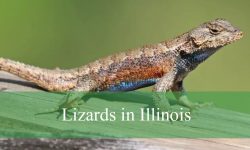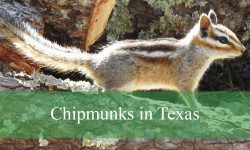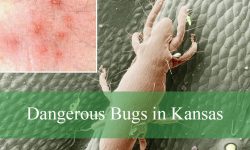Salamanders in Oregon are special animals that live in many different places across the state. From wet forests to cool mountain streams, Oregon has the right homes for many kinds of salamanders. These animals are important parts of nature, often hiding under logs, rocks, and leaves.
There are more than 20 types of salamanders in Oregon. Some are big like the Coastal Giant Salamander, while others are very small like the Oregon Slender Salamander. Each kind looks and acts differently.
This guide will show you 20 kinds of salamanders found in Oregon with pictures and simple ways to identify them. Knowing about these salamanders also helps us understand why protecting their homes is important for nature and the environment.
Common Salamanders Found in Oregon
Northwestern Salamander
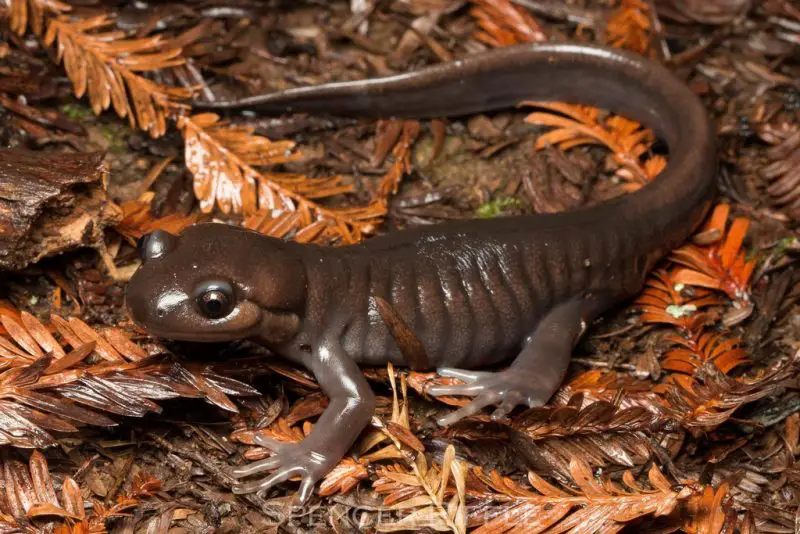
The Northwestern Salamander (Ambystoma gracile) is a medium to large-sized salamander native to the Pacific Northwest, including much of western Oregon. Adults typically measure between 5 to 9 inches long and are dark brown or blackish in color, often appearing uniform without obvious markings. Their skin is smooth and moist, and they have large parotoid glands behind the eyes, which secrete a mild toxin as a defense mechanism.
One of the distinguishing features of this species is its large head and robust body, making it relatively easy to recognize. Larvae can be neotenic, meaning they retain their gills and remain aquatic throughout their lives, especially in colder or higher-elevation environments. Adults that metamorphose tend to live a secretive, underground lifestyle.
Northwestern Salamanders are typically found in moist coniferous forests, especially near still or slow-moving water such as ponds, marshes, or forested wetlands. In Oregon, they are most common in the Coast Range and Cascade Mountains, where they breed in spring and early summer. They are nocturnal and spend most of the year hidden under logs, leaf litter, or underground.
Long-toed Salamander

The Long-toed Salamander (Ambystoma macrodactylum) is one of the most recognizable salamanders in Oregon due to its distinctive yellow to greenish dorsal stripe that runs from the head to the tail. This stripe is often irregular or blotchy. The species gets its name from the notably long fourth toe on its hind feet. Adults are generally slender, ranging from 3 to 5.5 inches in length.
Long-toed Salamanders are secretive and primarily nocturnal. They emerge during the rainy months to forage and breed, spending the drier summer months underground or beneath logs and rocks. In winter, they hibernate underground, often in rodent burrows or moist crevices. Breeding takes place in temporary ponds or vernal pools, where larvae develop before transforming and dispersing.
This species has a wide distribution across Oregon, from lowland valleys and forests to subalpine meadows and mountainous regions. They are particularly adaptable and can be found at elevations ranging from sea level up to 10,000 feet. They prefer moist environments but are more tolerant of drier upland areas than many other salamanders.
Tiger Salamander (Barred Tiger)
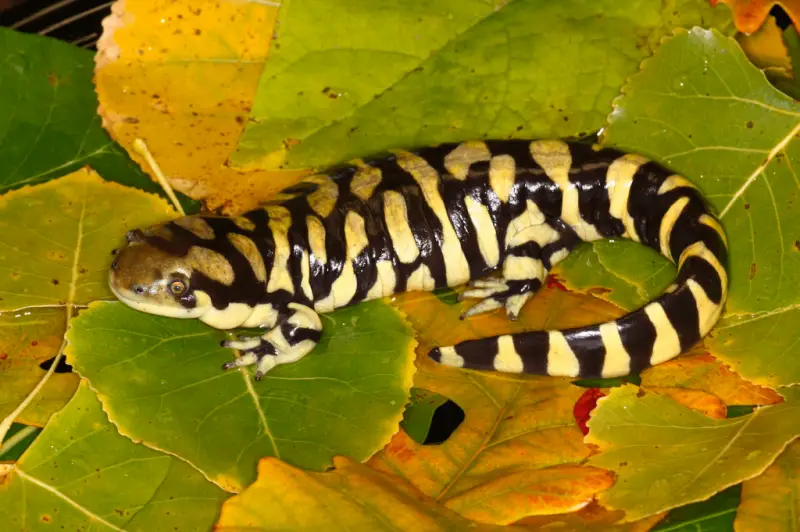
The Barred Tiger Salamander (Ambystoma mavortium), often simply referred to as the Tiger Salamander, is one of the largest terrestrial salamanders in North America. Adults typically measure 6 to 8.5 inches long, though some individuals may reach up to 13 inches. They are robust with yellow or cream-colored bars or blotches over a dark brown to black body, giving them their “tiger” appearance.
Tiger Salamanders are fossorial, spending most of their lives underground in self-dug or rodent burrows. They are active above ground mainly during wet conditions or the breeding season. Breeding usually occurs in early spring in temporary ponds or slow-moving waters, where females lay large clutches of eggs that develop into aquatic larvae.
In Oregon, the Barred Tiger Salamander is primarily found in the eastern part of the state, particularly in high desert, grasslands, and sagebrush habitats. Unlike many other salamanders, they can tolerate drier environments, provided they have access to seasonal pools or wetlands for reproduction. Their range does not typically extend into the wetter western portion of Oregon.
Cope’s Giant Salamander
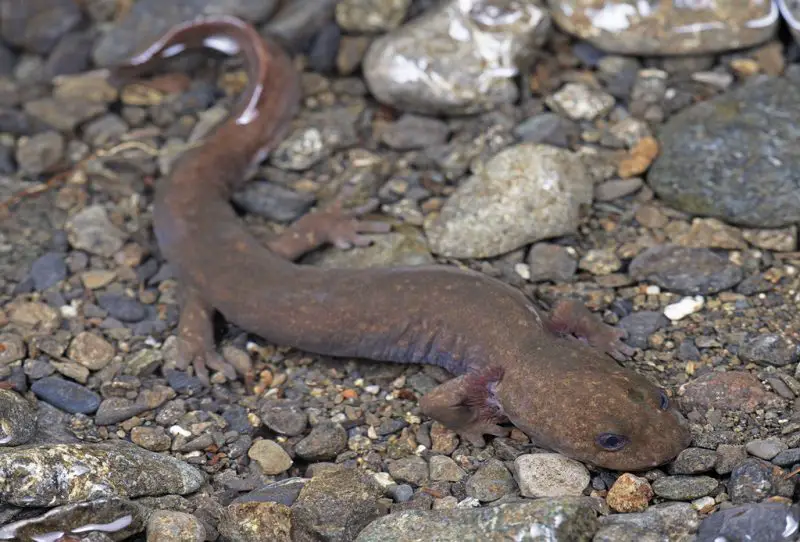
Cope’s Giant Salamander (Dicamptodon copei) is a relatively large species that is mostly aquatic throughout its life. Adults typically reach lengths of 4 to 6.5 inches and are characterized by a broad head, laterally compressed tail, and brown to grayish skin covered in light speckling or mottling. They retain gills into adulthood, which sets them apart from many other salamanders.
This species is primarily nocturnal and prefers cold, fast-flowing streams and seeps in forested environments. Cope’s Giant Salamanders are sit-and-wait predators that feed on aquatic invertebrates and smaller amphibians. Because they remain aquatic as adults, they are rarely seen far from their natal streams.
In Oregon, Cope’s Giant Salamanders are found in the northwestern corner of the state, particularly in the Coast Range near the Columbia River. They prefer undisturbed forested watersheds with clear, cold streams and are considered sensitive to habitat degradation, sedimentation, and water pollution due to their fully aquatic lifestyle.
Coastal Giant Salamander
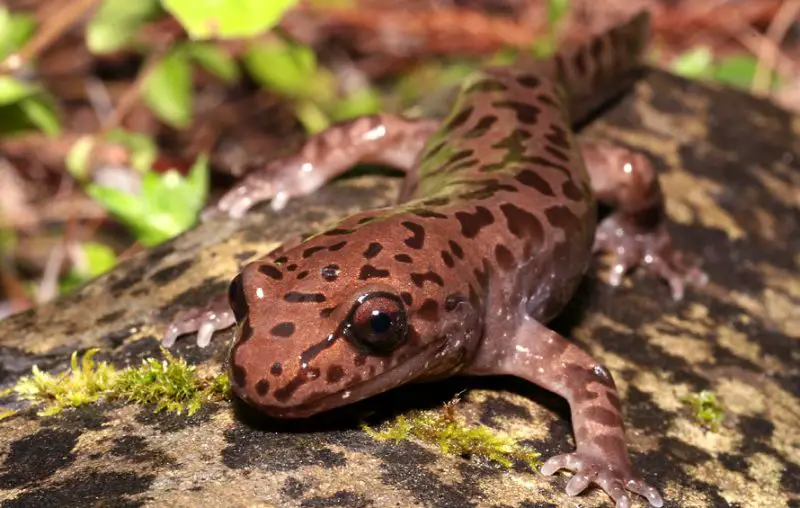
The Coastal Giant Salamander (Dicamptodon tenebrosus) is among the largest terrestrial salamanders in Oregon, with adults commonly reaching 6 to 8 inches, and some exceeding 13 inches. Their appearance includes a broad head, strong limbs, and a robust body with marbled or mottled brown and black coloration. They may be confused with Cope’s Giant Salamander, but the Coastal Giant has the ability to metamorphose into a terrestrial adult.
This species is dual-lifestage: some individuals remain aquatic with gills, while others undergo metamorphosis and transition to a terrestrial phase. Terrestrial adults are mostly nocturnal and secretive, hiding under logs, rocks, or leaf litter during the day. They are aggressive predators and will feed on insects, worms, and even small vertebrates.
Coastal Giant Salamanders are found in the moist forests of western Oregon, particularly in the Coast Range and western Cascades. They prefer cold, clear mountain streams for breeding and larval development, and healthy riparian zones are essential for their survival. Due to their dependence on both terrestrial and aquatic habitats, they are particularly vulnerable to deforestation and water quality issues.
Columbia Torrent Salamander

The Columbia Torrent Salamander (Rhyacotriton kezeri) is a small, stream-dwelling salamander native to the coastal regions of northwestern Oregon. Adults generally reach 2.5 to 4 inches in length and are easily recognized by their golden-brown to olive upper bodies and bright yellow bellies, often flecked with small black spots. Their eyes are large and prominent, and their limbs are relatively short.
This species is highly adapted to cold, fast-flowing mountain streams and seeps. They are often found under rocks or within moist crevices along shaded streambanks. Unlike many salamanders, the Columbia Torrent Salamander does not venture far from water, and even terrestrial movements are typically limited to short distances along the stream corridor.
In Oregon, they are primarily found in the Coast Range, particularly in old-growth forests with clear, unpolluted streams. They are highly sensitive to environmental disturbance and depend on cool temperatures, high humidity, and pristine water conditions. Logging, sedimentation, and habitat fragmentation pose major threats to their populations.
Southern Torrent Salamander
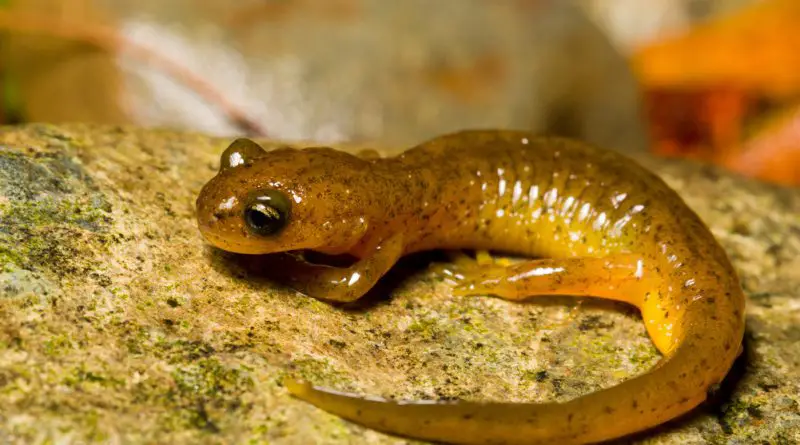
The Southern Torrent Salamander (Rhyacotriton variegatus) is another small aquatic salamander endemic to the Pacific Northwest, primarily found in southwestern Oregon. Adults measure between 2 to 4 inches long and are yellow to orange below with faint black flecking, while the dorsal surface is brown to olive. They have short limbs and relatively short tails, which are laterally compressed.
Southern Torrent Salamanders live in and around cold, rocky streams in moist coniferous forests. They are known to hide under moss, stones, and debris in seeps and streambanks. This species is lungless and breathes through its skin, making it extremely reliant on clean, oxygen-rich water and consistently damp environments.
In Oregon, they are distributed from the central Coast Range southward to the Siskiyou Mountains. These salamanders are typically restricted to shaded forested habitats and are rarely found in areas with altered hydrology or high sediment levels. Due to their narrow environmental needs, they are considered sensitive to habitat degradation and climate change.
Cascade Torrent Salamander
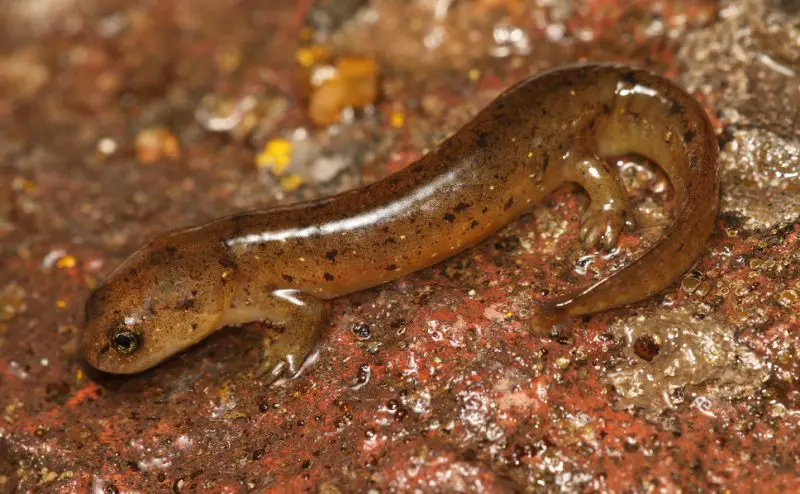
The Cascade Torrent Salamander (Rhyacotriton cascadae) is a small, reclusive amphibian restricted to the western slopes of the Cascade Mountains in Oregon. Adults reach about 2.5 to 4 inches in length, featuring a brown to dark olive back and a yellow or orange belly, sometimes spotted with black flecks. Their eyes are large and slightly protruding, a useful trait for spotting them among rocks and debris.
Like other members of its genus, the Cascade Torrent Salamander is lungless and relies on moist skin for respiration. They inhabit seeps, cold springs, and small headwater streams, where they hide under rocks and moss during the day. Activity is generally nocturnal or during overcast, damp conditions.
This species is found exclusively in Oregon’s western Cascades, where it is confined to undisturbed forest habitats with cool, well-shaded streams. Their narrow habitat requirements and low dispersal ability make them especially vulnerable to habitat fragmentation, logging, and rising stream temperatures.
Rough-skinned Newt
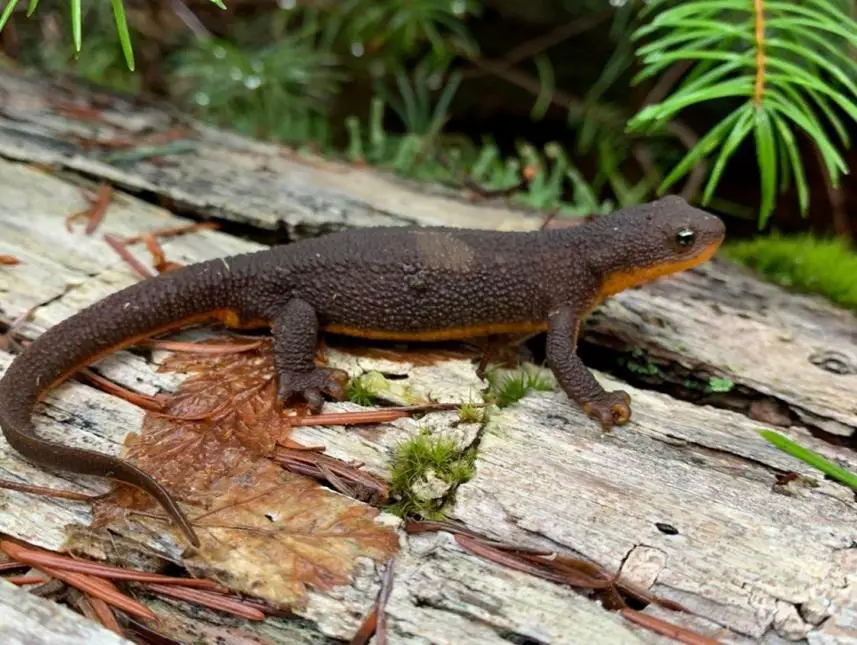
The Rough-skinned Newt (Taricha granulosa) is one of the most well-known amphibians in the Pacific Northwest and is easily identified by its rough, dark brown skin and bright orange to yellow underside. Adults range from 5 to 8 inches long and secrete a powerful neurotoxin (tetrodotoxin) from their skin, which acts as a defense mechanism against predators.
Rough-skinned Newts have a unique seasonal behavior. During the breeding season, they are found in ponds, lakes, and slow-moving streams, often in large numbers. Males develop smooth skin and swollen cloacal areas during this time. Outside of the breeding season, they become terrestrial, living in moist forest environments under logs, leaf litter, or rocks.
In Oregon, this species has a wide distribution across both western and parts of eastern regions, from coastal forests to foothills and even high-elevation meadows. They are relatively adaptable but still depend on moist habitats and aquatic breeding sites. Despite their toxic defense, some predators such as the Common Gartersnake have evolved resistance to their toxin.
Dunn’s Salamander

Dunn’s Salamander (Plethodon dunni) is a slender, lungless salamander native to the Pacific Northwest, primarily found in the Coast Range and parts of the western Cascade foothills of Oregon. Adults are small to medium-sized, measuring around 2.5 to 4.5 inches in length. Their coloration is usually dark brown to black with a distinctive brassy or copper-colored stripe running along the back and tail.
This salamander is terrestrial and is most often encountered in moist forested environments, especially near seeps, springs, and small streams. Because they lack lungs, Dunn’s Salamanders require consistently moist microhabitats to facilitate cutaneous respiration. They are mostly nocturnal and retreat under rocks, logs, or moss during the day.
In Oregon, Dunn’s Salamanders are primarily found west of the Cascades, where they inhabit cool, shaded forests with minimal soil disturbance. They are generally non-migratory and have small home ranges. Logging, road construction, and changes in forest hydrology can pose significant threats to their survival due to their reliance on stable moisture and temperature conditions.
Larch Mountain Salamander

The Larch Mountain Salamander (Plethodon larselli) is a small, elusive, lungless salamander native to the Cascade Mountains in northern Oregon and southern Washington. Adults typically reach 2.5 to 4 inches in length and are characterized by a dark brown to black body with a reddish or copper-colored stripe along the back and upper tail. The underside is light with a mix of white and orange mottling.
This species is terrestrial and secretive, spending most of its life beneath moss, leaf litter, and rocks in cool, moist environments. It is mainly active during damp weather or at night and is known for its quick, jerky movements when disturbed. The Larch Mountain Salamander lays its eggs in hidden, damp locations on land rather than in water.
In Oregon, it is limited to a small range in the northern Cascades near the Columbia River Gorge, particularly in rocky forested slopes and talus habitats. Because of its narrow distribution and sensitivity to habitat disturbance, it is considered a species of conservation concern. Logging and increased human activity in its range can have significant impacts on its populations.
Western Red-backed Salamander
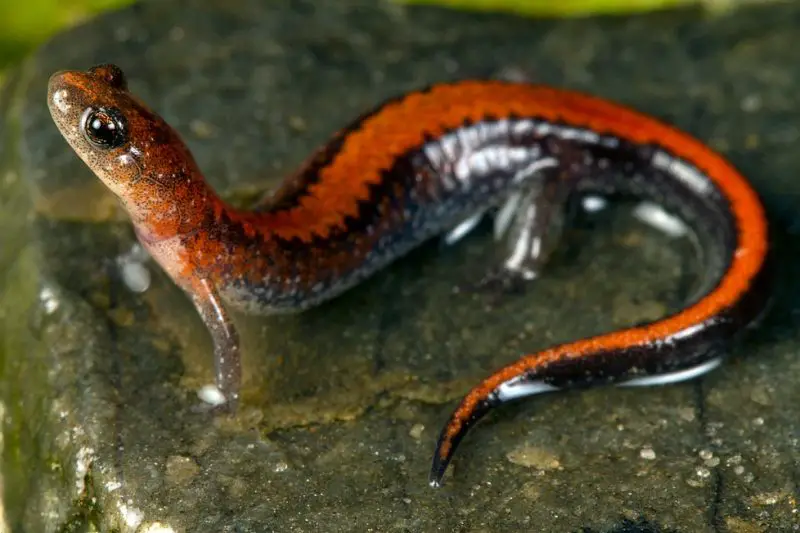
The Western Red-backed Salamander (Plethodon vehiculum) is a slender, lungless salamander commonly found in forested areas of western Oregon. Adults typically grow to 2.5 to 4 inches long and are most easily recognized by the reddish, orange, or sometimes yellow stripe running down the back from head to tail, although some individuals lack the stripe entirely.
This salamander is entirely terrestrial and does not require aquatic habitats for reproduction. It lives in moist, shaded environments under logs, rocks, bark, and forest debris. It is nocturnal and emerges during rainy or overcast conditions to feed on small invertebrates like ants, mites, and spiders. Eggs are laid in damp soil or moss and develop directly into miniature salamanders without a larval stage.
Western Red-backed Salamanders are widespread in Oregon’s coastal and Cascade mountain forests, often thriving in both mature and second-growth stands. They play an important ecological role in forest floor food webs and are highly sensitive to habitat drying and soil compaction, making them good indicators of environmental health.
Del Norte Salamander
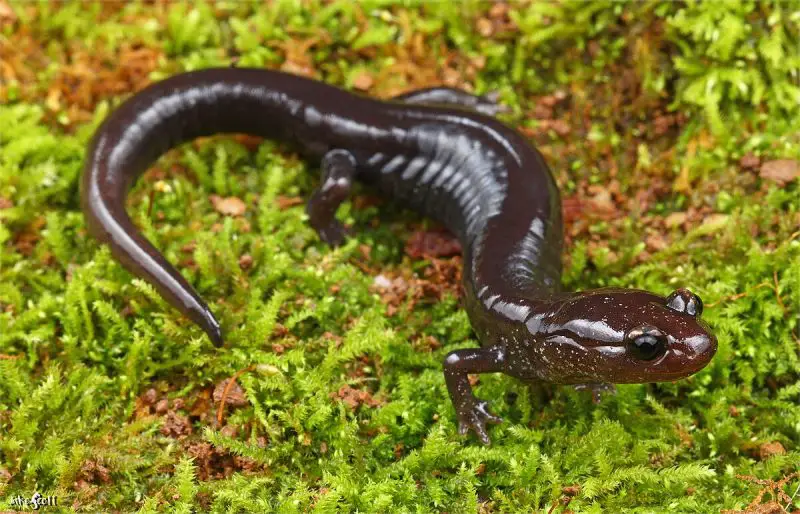
The Del Norte Salamander (Plethodon elongatus) is a narrow-bodied, lungless salamander that reaches 3 to 5 inches in length and is known for its elongated torso and tail. It is usually dark brown to black with a reddish-brown or bronze dorsal stripe that varies in width. The belly is dark and unmarked, and the skin texture is smooth.
This species is terrestrial and highly secretive, typically found in forested talus slopes, rock outcrops, and moss-covered boulders. It avoids open areas and requires consistently moist microhabitats to survive. During dry periods, it retreats deep into rocky crevices. Like other Plethodontid salamanders, it breathes entirely through its skin and the lining of its mouth.
In Oregon, the Del Norte Salamander is found in the far southwestern corner of the state, especially in the Klamath-Siskiyou region. It is closely associated with old-growth forests and undisturbed rocky habitats. Due to its narrow distribution and specific habitat requirements, it is considered vulnerable to habitat loss, particularly from logging and road construction.
Siskiyou Mountains Salamander
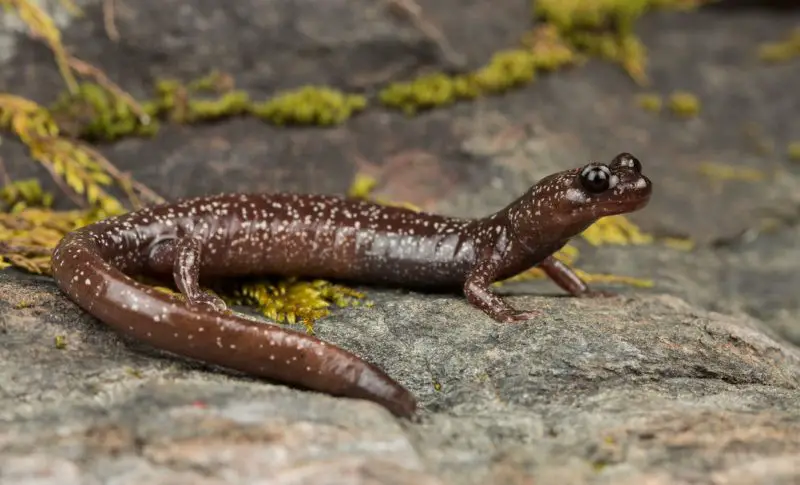
The Siskiyou Mountains Salamander (Plethodon stormi) is a rare and highly localized species found only in a small portion of the Klamath-Siskiyou Mountains. Adults measure around 3.5 to 5 inches in length and have a purplish-brown to reddish-brown back often marked with fine white or silvery speckling. Their tails are long and slender, accounting for nearly half of their body length.
This salamander is entirely terrestrial and inhabits moist, rocky talus slopes within mixed conifer forests. It prefers cool, shaded environments with deep leaf litter and decaying logs. It is most active during wet seasons and is typically found under surface debris or within rock crevices. Like other members of its genus, it lays eggs on land that hatch into fully formed juveniles.
In Oregon, its range is extremely limited to the southern Siskiyou Mountains near the California border. Its habitat is highly fragmented, and the species is considered threatened due to its limited distribution and susceptibility to logging, climate change, and human disturbance. Conservation efforts focus on preserving intact forested talus slopes and maintaining microclimate stability.
Ensatina (Ensatina eschscholtzii oregonensis & picta)
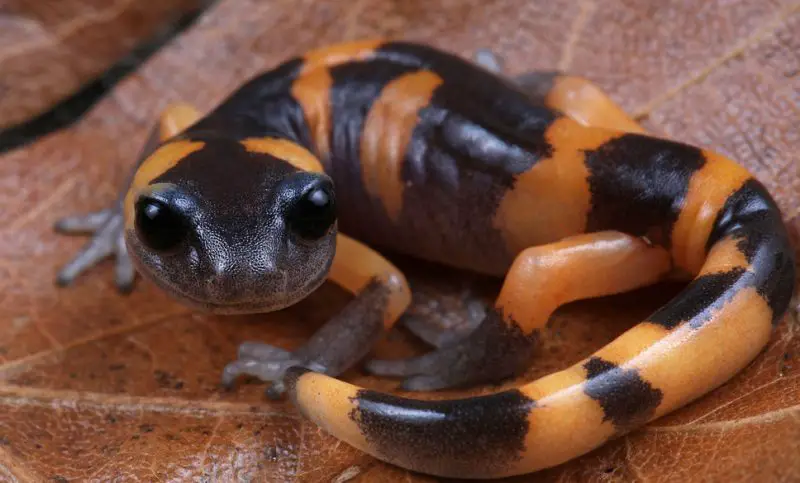
Ensatinas are a complex group of lungless salamanders with several subspecies found throughout Oregon. Ensatina eschscholtzii oregonensis, the Oregon Ensatina, and E. e. picta, the Painted Ensatina, are both small salamanders, typically 2.5 to 4 inches long. They have slender bodies, large eyes, and a noticeable constriction at the base of the tail. Coloration varies, but Oregon Ensatinas are often reddish-brown to orange, while Painted Ensatinas have striking mottled patterns of black and white or gray.
These salamanders are fully terrestrial and are typically found in moist conifer and mixed forests. They hide under logs, bark, stones, and leaf litter and are primarily active during rainy seasons or damp nights. Like other Plethodontids, they rely on their skin for respiration and do not require aquatic habitats for any part of their life cycle. Eggs are laid in moist, concealed locations and hatch directly into juvenile salamanders.
In Oregon, Ensatinas are common in forested regions of the Coast Range, Cascades, and Siskiyous. They are adaptable to different elevations and forest types, provided humidity is sufficient. Despite their broad range, they are sensitive to habitat fragmentation and are an important indicator species for the health of forest ecosystems.
Clouded Salamander
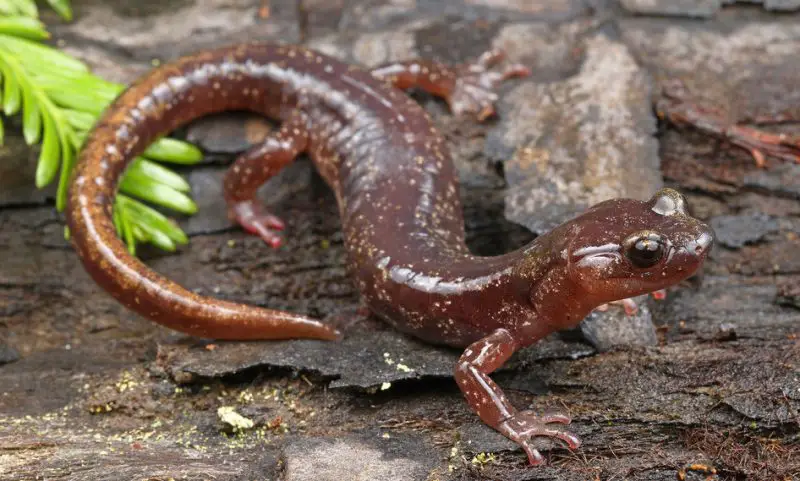
The Clouded Salamander (Aneides ferreus) is a small, slender, and agile salamander native to forested regions of western Oregon. Adults typically measure 2.5 to 4 inches in length and are dark brown or grayish-black with irregular silvery or golden flecks, giving them a “clouded” appearance. They have long limbs and square-tipped toes adapted for climbing.
Unlike many other salamanders, the Clouded Salamander is partially arboreal and often climbs under loose bark or within decaying stumps. It prefers moist forest environments, especially those with abundant coarse woody debris and decomposing logs. The species is nocturnal and secretive, foraging for small invertebrates during the night and sheltering during the day.
In Oregon, the Clouded Salamander is found primarily in the Coast Range and western slopes of the Cascades. It thrives in both old-growth and second-growth Douglas-fir forests, though it is more abundant where rotting wood and high humidity are present. Logging and forest thinning can pose threats by reducing available cover and increasing desiccation risk.
Black Salamander
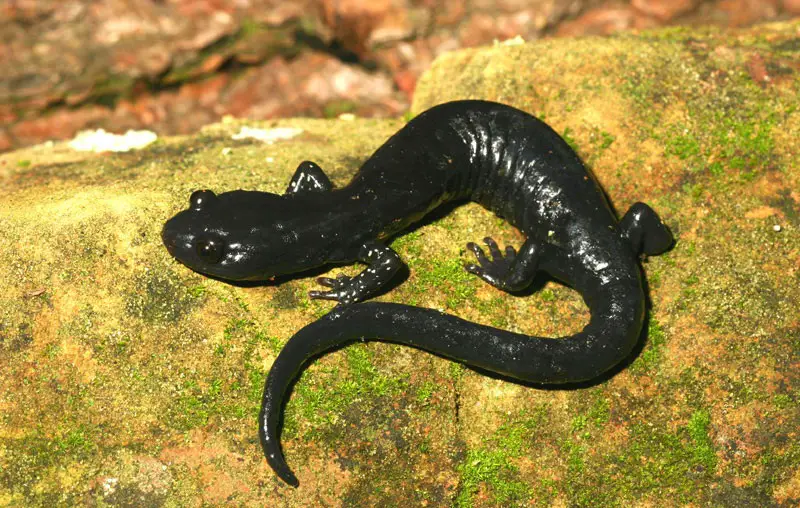
The Black Salamander (Aneides flavipunctatus) is a robust and striking species found in far southwestern Oregon and into northern California. Adults usually measure 3 to 5 inches long and have a jet-black body sometimes speckled with faint yellow or white flecks. Their large, square toe pads and prehensile tails make them excellent climbers.
This species is terrestrial but often uses both ground-level and elevated habitats, including under logs, inside decaying wood, or in moist rock crevices. Black Salamanders are aggressive foragers and may even exhibit territorial behavior. They are active during cool, damp conditions and retreat underground or into deep cover during dry or hot periods.
In Oregon, their range is extremely limited to the Siskiyou Mountains and other rugged, forested landscapes near the California border. They are closely associated with moist coniferous forests and shaded, rocky habitats. Due to their narrow range and specialized habitat needs, they are considered vulnerable to habitat alteration, including road building and timber harvest.
Klamath Black Salamander
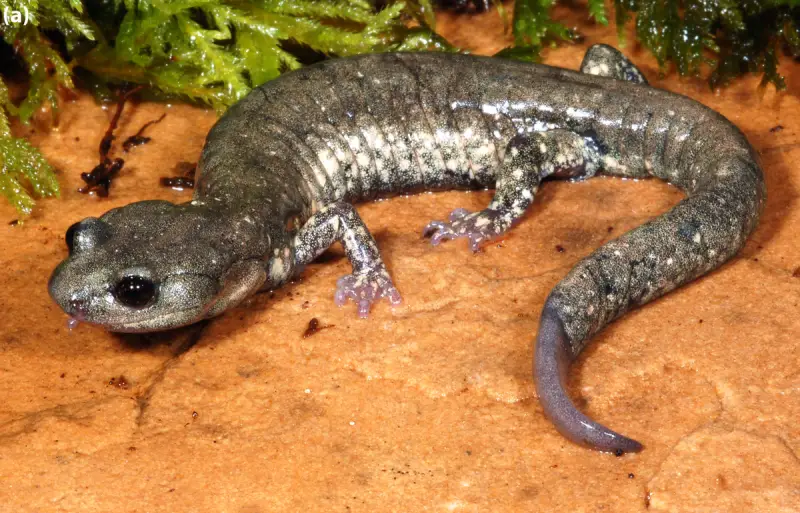
The Klamath Black Salamander (Aneides klamathensis) was formerly considered part of the Black Salamander species group but was recently recognized as a distinct species. It is native to southern Oregon and northern California, particularly in the Klamath-Siskiyou region. Adults range from 3 to 5.5 inches in length and are dark black with bright white to silvery spotting.
This species shares many behavioral traits with its close relatives, including a preference for cool, moist forests and the use of logs, rocks, and bark for cover. It is a lungless salamander that breathes through its skin and the lining of its mouth. The Klamath Black Salamander is largely terrestrial and primarily active during wet conditions.
In Oregon, its range is restricted to parts of Josephine and Jackson counties, typically at low to mid elevations in forested areas with ample cover. The species’ limited distribution and reliance on undisturbed habitat make it vulnerable to logging, habitat fragmentation, and climate shifts that may alter local humidity and temperature conditions.
Oregon Slender Salamander
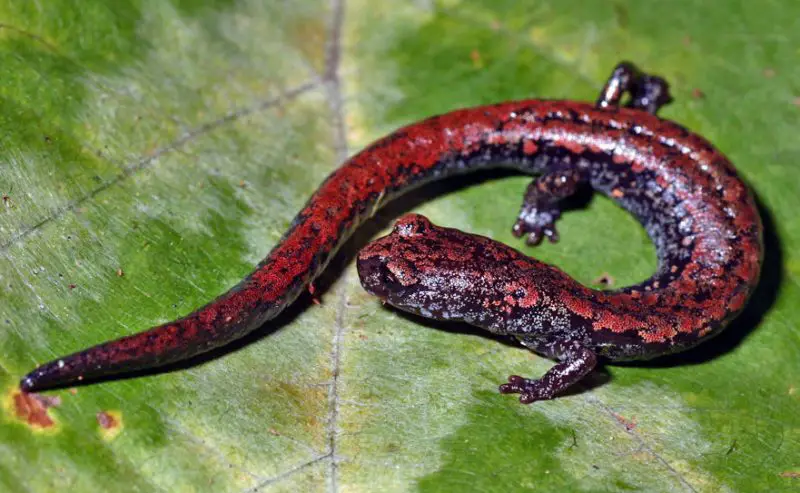
The Oregon Slender Salamander (Batrachoseps wrighti) is a highly specialized and rare species found only in a small portion of northwestern Oregon. Adults are very slender and elongated, typically measuring 2.5 to 3.5 inches long. They are dark brown to reddish-brown with a narrow head and tiny limbs, giving them a worm-like appearance.
This salamander is secretive and spends much of its life underground or hidden beneath mossy logs, bark, or forest debris. It is lungless and breathes through its skin, making it extremely sensitive to moisture loss. It is mostly nocturnal and inactive during dry periods, emerging during wet weather to forage for small invertebrates.
The Oregon Slender Salamander is found in mature and old-growth Douglas-fir forests of the western Cascade foothills, particularly in Multnomah and Clackamas counties. It is a habitat specialist and has been designated a species of conservation concern due to its limited range and the loss of old-growth forests. Protection of intact forest ecosystems is critical for its survival.
California Slender Salamander
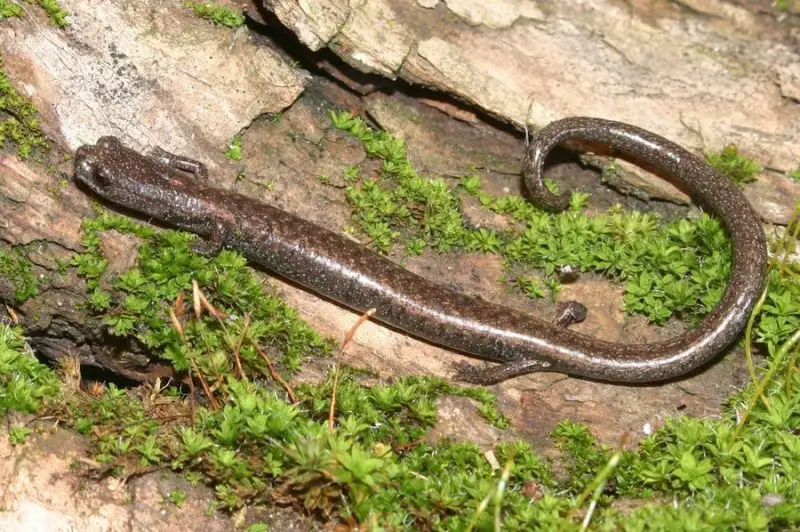
The California Slender Salamander (Batrachoseps attenuatus) is a tiny, narrow-bodied salamander that reaches only about 2 to 3 inches in length. Its coloration varies but is typically brown, gray, or reddish with a faint dorsal stripe. Like other slender salamanders, it has extremely small limbs and a long, flexible tail that accounts for over half its total length.
This species is adapted to living in leaf litter, under bark, and within the upper soil layers of moist forest habitats. It is fully terrestrial and lungless, relying on damp environments for respiration. California Slender Salamanders are slow-moving and most active during rainy seasons. Eggs are laid in small clusters in moist soil and hatch directly into miniature salamanders.
In Oregon, this species is found only in the far southwestern part of the state near the California border, particularly in coastal forests and the Klamath Mountains. It is typically associated with oak woodlands and mixed evergreen forests. Though locally common, it is vulnerable to habitat loss and fragmentation from logging and land conversion.
Frequently Asked Questions About Salamanders in Oregon
What types of salamanders are found in Oregon?
Oregon is home to a diverse range of salamander species, including the Northwestern Salamander, Long-toed Salamander, Tiger Salamander (Barred Tiger), Coastal Giant Salamander, and many more. The state’s variety of habitats—ranging from coastal forests and mountain streams to dry inland valleys—supports both aquatic and terrestrial salamanders.
Where do salamanders typically live in Oregon?
Salamanders in Oregon inhabit moist environments such as coniferous forests, mountain streams, ponds, wetlands, and damp talus slopes. Many species prefer cool, shaded areas with plenty of cover like logs, rocks, and leaf litter. Aquatic species are often found in cold, clean streams or ponds, while terrestrial species tend to stay under forest debris or in underground burrows.
Are all salamanders in Oregon aquatic?
No, not all Oregon salamanders are aquatic. Some species, like the Coastal Giant Salamander and Northwestern Salamander, have aquatic larvae but become terrestrial adults. Others, such as the Western Red-backed Salamander and Ensatina species, are fully terrestrial throughout their life cycle and do not require water for reproduction.
How can I identify a salamander in Oregon?
Identification usually involves observing physical characteristics such as size, color patterns, presence or absence of spots or stripes, and habitat. For example, the Long-toed Salamander has a distinctive yellow stripe down its back and a long fourth toe, while the Rough-skinned Newt has rough, dark skin with a bright orange belly. Behavior and habitat location also help in identification.
Are salamanders in Oregon endangered or protected?
Some salamander species in Oregon are considered species of concern due to limited ranges or habitat loss. For instance, the Larch Mountain Salamander and Oregon Slender Salamander have restricted distributions and are sensitive to environmental changes. Conservation efforts focus on protecting their habitats and maintaining water quality.
What threats do Oregon salamanders face?
Habitat destruction from logging, urban development, road construction, and pollution poses the greatest threats to salamander populations in Oregon. Climate change, which can alter moisture levels and temperatures, also impacts their survival. Because many salamanders depend on moist microhabitats and clean water, they are vulnerable to environmental disturbances.
How can I help protect salamanders in Oregon?
To help protect salamanders, avoid disturbing their natural habitats, especially during breeding seasons. Supporting forest conservation, reducing pesticide and chemical runoff, and participating in citizen science or local habitat restoration projects can make a positive difference. Educating others about salamanders’ ecological importance also promotes their protection.

